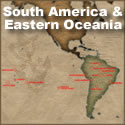The following is an excerpt from an article by Lars
Krutak titled - Embodied Symbols of the South Seas: Eastern Oceania
The Marquesas
The Marquesan archipelago consists of six inhabitable islands and other islets located approximately nine-hundred miles northeast of Tahiti. The island nation is divided into a northwestern group (Nukuhiva, 'Ua Pou, and 'Ua Huka) and a south-eastern group (Hiva Oa, Tahuata, and Fatuhiva) where dialectical differences and tattooing styles evolved since the region was settled by ancient mariners about 100 B.C.
The German explorer and ethnologist Karl von den Steinen, who visited the isles in 1891, listed over one-hundred and seventy individually named tattooing motifs which is remarkable since the tradition was "banned" by French officials approximately fifty years before that time.
Unlike other regions of Polynesia where descent and genealogical heritage from gods were the primary avenues for status and political control, the sociopolitical milieu of the Marquesas was more relaxed, devolved, and egalitarian. For example, rather than a rigid, stratified society controlled by ruling chiefs, the Marquesan world was sufficiently modified to the extent that property owners ('akatia), warriors (toa), political leaders, and even female shamans (etua) could also achieve great influence and power. In fact, on Fatuhiva - one of the most "democratic" of all the isles - a missionary that sought to know who was king was told: "You are king, I am king, we are all kings."
Due to the nature of indigenous political organization in the Marquesas, tattooing was not confined to certain ranks, classes, or the sexes. In fact, certain sacred chiefs of the highest rank were not tattooed at all. However, fine work was widely enjoyed by other chiefs, their warriors, and wealthy individuals who could afford to employ the best artists. Furthermore, only they could withstand the attendant expenses associated with feeding the tattoo artist and his assistants as well as other individuals (ka'ioi) who built the special tattooing house (oho'au) for the occasion.
Not surprisingly, these facts did not escape the attention of early writers who were fascinated by such customs, and today our knowledge of Marquesan tattooing is largely confined to observations revolving around the heavy marking of the male elite.
One of these early writers was George
Heinrich von Langsdorff, a German naturalist accompanying Russian explorer Ivan Fedorovich Krusenstern, who visited the islands in 1804. (Read
an excerpt from his 1817 book Voyages and Travels in Various Parts of the World)
Tattoo Museum Bibliography, Resources and Links
 See all Eastern Oceania Tattoo Culture Articles here
See all Eastern Oceania Tattoo Culture Articles here
Tattoo History Source Book by Steve Gilbert
Trisha Allen - www.thepolynesiantattoo.com
Meanings of Polynesian Tribal Tattoo Designs - Online Dictionary
NEXT >>
The Marshalls
